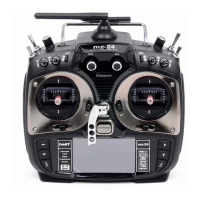
Do you have a question about the GRAUPNER mz-24 HOTT and is the answer not in the manual?
| Channels | Up to 12 |
|---|---|
| Telemetry | Yes |
| HoTT | Yes |
| Frequency | 2.4 GHz |
| Modulation | FHSS |
| Compatibility | Graupner HoTT |
Accessing the BASE menu via the transmitter's power button.
Step-by-step setup for new models via manual configuration.
Guided setup of model functions and flight.
Setting servo travel endpoints and limitations for each channel.
Inverting the direction of servo movement.
Adjusting servo neutral position for fine control surface trim.
Procedure for linking transmitter to receiver.
Setting failsafe positions (Hold or F/S) for channels.
Setting failsafe positions (Hold/F/S) for each channel.
Testing servo operation and viewing movement in a graph.
Setting up AUX channels with switches, volumes, or levers.
Setting up Q.LINK with various switches for flight conditions.
Setting control rates and sensitivity for channels.
Linking switches to control D/R and EXP functions.
Marking and adjusting pitch curve points via graph.
Adjusting individual pitch curve points.
Marking and adjusting throttle curve points via graph.
Adjusting individual throttle curve points.
Configuring gyro sensitivity and governor rates.
Adjusting gyro sensitivity and governor activation.
Assigning a switch for throttle hold functionality.
Configuring aileron, elevator, and pitch travel/direction.
Mixing functions for AILE, ELEV, PITC adjustments.
Mixing for aileron and elevator control.
Mixing for pitch and aileron/elevator control.
Maintaining RPM during pitch, aileron, elevator inputs.
Setting up linear mixing for various channels.
Setting operation values for liner mixes.
Configuring curve mixing for channels.
Adjusting curve points and operation via graph.
Configuring instructor and pupil roles for training.
Linking teacher and pupil transmitters wirelessly or via DSC.
Selecting the receiver for telemetry data transmission.
Checking telemetry data of receivers.
Setting servo direction and neutral position.
Setting maximum travel amount for servos.
Editing channel connections between receiver and transmitter.
Choosing between HOLD, OFF, or FAIL SAFE modes.
Configuring the delay for failsafe activation.
Setting servo position when failsafe is active.
Setting all failsafe positions at once.
Configuring curve types (A, B, C) for channels.
Testing servo operation and parameters like voltage/temp.
Setting maximum and minimum servo travel values.
Setting low voltage alarm for receiver battery.
Setting temperature alarms for the receiver.
Configuring receiver signal output types (ONCE, SAME, SUMO, SUMD).
Procedure for creating new Q.LINK configurations.